Marsipankake, also known as marzipan princess cake or hvit dame kake, is a dessert from Norway featuring layers of sponge cake, vanilla cream, various puddings, jams, and other additives before being topped in a layer of marzipan. [1] [2]
Marsipankake, also known as marzipan princess cake or hvit dame kake, is a dessert from Norway featuring layers of sponge cake, vanilla cream, various puddings, jams, and other additives before being topped in a layer of marzipan. [1] [2]
The name of the cake was coined by the German Kaiser Wilhelm II on a trip to Bergen. During his visits, he would be served marsipankake, in which he would respond with, "Ah, nochmal die weisse Dame," or, "Ah, again the white lady." [3] While originating in Bergen, the cake has since found its way to bakeries across Norway and other Scandinavian regions.

Dessert is a course that concludes a meal. The course consists of sweet foods, such as confections, and possibly a beverage such as dessert wine and liqueur. In some parts of the world, such as much of Central Africa and West Africa, and most parts of China, there is no tradition of a dessert course to conclude a meal.

Cake is a flour confection made from flour, sugar, and other ingredients, and is usually baked. In their oldest forms, cakes were modifications of bread, but cakes now cover a wide range of preparations that can be simple or elaborate, and which share features with desserts such as pastries, meringues, custards, and pies.

A wedding cake is the traditional cake served at wedding receptions following dinner. In some parts of England, the wedding cake is served at a wedding breakfast; the 'wedding breakfast' does not mean the meal will be held in the morning, but at a time following the ceremony on the same day. In modern Western culture, the cake is usually on display and served to guests at the reception. Traditionally, wedding cakes were made to bring good luck to all guests and the couple. Nowadays, however, they are more of a centerpiece to the wedding and are not always even served to the guests. Some cakes are built with only a single edible tier for the bride and groom to share, but this is rare since the cost difference between fake and real tiers is minimal.

Marzipan is a confection consisting primarily of sugar, honey, and almond meal, sometimes augmented with almond oil or extract.
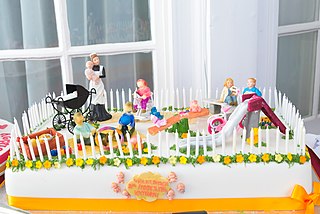
A birthday cake is a cake eaten as part of a birthday celebration. Birthday cakes are often layer cakes with frosting served with small lit candles on top representing the celebrant's age. Variations include cupcakes, cake pops, pastries, and tarts. The cake is often decorated with birthday wishes and the celebrant's name.

Fruitcake is a cake made with candied or dried fruit, nuts, and spices, and optionally soaked in spirits. In the United Kingdom, certain rich versions may be iced and decorated.

Sachertorte is a chocolate cake, or torte of Austrian origin, invented by Franz Sacher, supposedly in 1832 for Prince Metternich in Vienna. It is one of the most famous Viennese culinary specialties.

Baumkuchen is a kind of spit cake from German cuisine. It is also a popular dessert in Japan. The characteristic rings that appear when sliced resemble tree rings, and give the cake its German name, Baumkuchen, which literally translates to "tree cake" or "log cake".

A Swiss roll, jelly roll, roll cake, cream roll, roulade or Swiss log is a type of rolled sponge cake filled with whipped cream, jam, or icing. The origins of the term are unclear; in spite of the name "Swiss roll", the cake is believed to have originated elsewhere in Central Europe, possibly Austria or Slovenia. It appears to have been invented in the nineteenth century, along with Battenberg cake, doughnuts, and Victoria sponge. In the U.S., commercial versions of the cake are sold with the brand names of Ho Hos, Yodels, Swiss Cake Rolls, and others. A type of roll cake called Yule log is traditionally served at Christmas.

Orkla ASA is a Norwegian conglomerate operating in the Nordic region, Eastern Europe, Asia and the US. At present, Orkla operates in the branded consumer goods, aluminium solutions and financial investment sectors. Orkla ASA is listed on the Oslo Stock Exchange and its head office is in Oslo, Norway. As of 31 December 2021, Orkla had 21,423 employees. The Group's turnover in 2021 totalled NOK 50.4 billion.
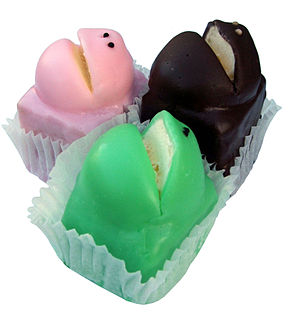
The frog cake is an Australian dessert in the shape of a frog's head, composed of sponge cake and cream covered with fondant. It was created by the Balfours bakery circa 1923, and soon became a popular treat in South Australia. Originally frog cakes were available exclusively in green, but later brown and pink were added to the range. Since then other variations have been developed, including seasonal varieties. The frog cake has been called "uniquely South Australian", and has been employed in promoting the state. In recognition of its cultural significance, in 2001 the frog cake was listed as a South Australian Heritage Icon by the National Trust of South Australia.
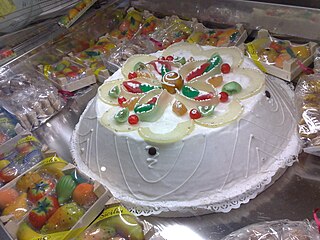
Cassata or cassata siciliana is a traditional cake from Sicily, Italy. Cassata consists of round sponge cake moistened with fruit juices or liqueur and layered with ricotta cheese and candied fruit, a filling also used with cannoli. Cassata has a shell of marzipan, pink and green coloured icing, and decorative designs. Cassata may also refer to a Neapolitan ice cream containing candied or dried fruit and nuts.

Kransekage (Danish) or kransekake (Norwegian) is a traditional Danish and Norwegian confection, often eaten on special occasions in Scandinavia. In English, the name means wreath cake. In Norway it is alternatively referred to as tårnkake and often prepared for Constitution Day celebrations, Christmas, weddings, and baptisms. In Denmark it is typically eaten as part of New Year celebrations, while a variation of the cake, overflødighedshorn, is traditionally served at weddings and baptisms.

Cake decorating is the art of dressing up a cake for special occasions such as birthdays, weddings, national or religious holidays, or as a promotional item. It is a form of sugar art that uses materials such as icing, frosting, fondant, and other edible decorations. Cake decorating can go beyond the simple art of dressing up a cake. Cake decorators who have honed their skills in sugar art, have been featured on TV channels such as: TLC, Food Network, and Discovery Family. They give us a glimpse into different techniques of cake decorating such as molding, sculpting, and piping. An artisan may take on simple or elaborate three-dimensional shapes as part of decoration or the cake in its entirety. Chocolate is commonly used to decorate a cake. It can be melted and mixed with cream to make a ganache or cocoa powder can be lightly dusted on top of a cake.
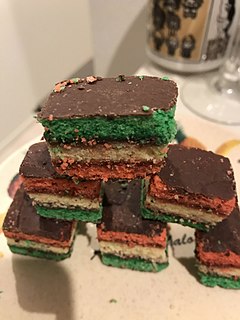
Rainbow cookie or rainbow cake usually refers to a three-layered almond-flavored Italian-American cookie, but can also refer to any of a number of rainbow-colored confections.

Princess cake is a traditional Swedish layer cake or torte consisting of alternating layers of airy sponge cake, pastry cream, raspberry jam and a thick-domed layer of whipped cream. The cake is covered by a layer of marzipan, giving it a smooth rounded top. The marzipan overlay is usually green, sprinkled with powdered sugar, and often decorated with a pink marzipan rose.
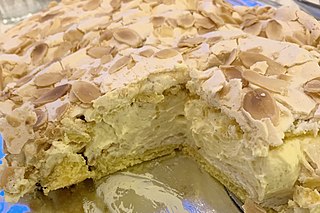
Kvæfjord cake, or Verdens beste, is a sponge cake baked with meringue, vanilla cream and almonds.
Aboukir is type of a dessert make with a sponge cake that has been baked in a Charlotte mold, divided into multiple layers which are layered with chestnut cream. The assembled dessert is iced with coffee-flavoured fondant and decorated with a garnish of chopped pistachios. According to Larousse Gastronomique the dessert is of French origins. A frozen variation with pistachio ice cream is called an Aboukirbombe.